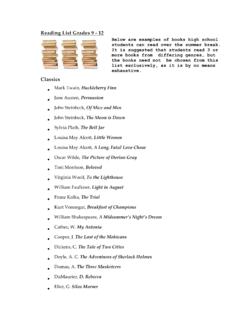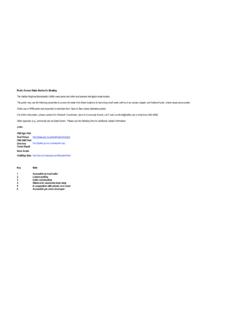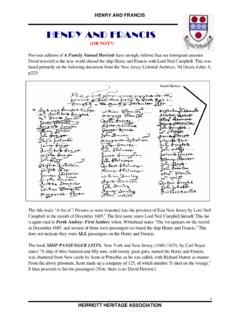Transcription of Operation Just Cause - Defense Technical Information Center
1 Operation just CauseLessons for operations OtherThan WarJennifer Morrison Taw19961114 O65 Arroyo CenterDTIC QUALM INSPECTED IThe research described in this report was sponsored by the United States Armyunder Contract MDA903-9 : 0-8330-2405-1 Copyright 1996 RANDAll rights reserved. No part of this book may be reproduced in any form by anyelectronic or mechanical means (including photocopying, recording, or informationstorage and retrieval) without permission in writing from is a nonprofit institution that helps improve public policy through researchand analysis. RAND's publications do not necessarily reflect the opinions or policiesof its research 1996 by RAND1700 Main Street, PO. Box 2138, Santa Monica, CA 90407-2138 RAND URL: order RAND documents or to obtain additional Information , contact DistributionServices: Telephone: (310) 451-7002; Fax: (310) 451-6915; Internet: just CauseLessons for operations OtherThan WarJennifer Morrison TawPrepared for theUnited States ArmyArroyo CenterApproved for public release; distribution unlimitediiiPrefaceThis monograph was prepared as part of a project entitled "Military OperationsOther Than War (OOTW).
2 " The purpose of this project was to assess howdemographic changes will affect future conflict (limited conventional fighting, aswell as nonconventional fighting, , insurgency) and Army combat(conventional and counterinsurgency), as well as noncombat missions(peacekeeping, civil affairs, psychological operations , humanitarian assistance,disaster relief, etc.).Several case studies were prepared as part of this project. Each study Army roles and functions in military operations other than war and assessesthe range of missions and requirements the Army is likely to face in the work is complemented by another paper that looks specifically at theevolving role of special operations forces in military operations other than project's final phase analyzed how increased involvement in militaryoperations other than war should affect Army doctrine, training, andequipment, and it made specific recommendations on force structure (includingactive/reserve mix)
3 And operational requirements for military operations onurban terrain, foreign internal Defense , counterinsurgency, peace supportoperations, civil affairs, psychological operations , humanitarian assistance, andcoalition monograph was prepared as a final report for the project "MilitaryOperations Other Than War," which is being conducted for the Army Office ofthe Deputy Chief of Staff for operations . The research was conducted in theStrategy and Doctrine Program of RAND's Arroyo Center , a federally fundedresearch and development Center sponsored by the United States monograph may be of interest to those involved in planning, preparing for,and participating in operations other than war. Many of the issues Army involvement in OOTW that have since arisen in Somalia, Bosnia,Haiti, and Rwanda could have been predicted in light of circumstances.
4 IiiSum m ary .. viiAcknowledgments .. xiAbbreviations .. xiii1. INTRODUCTION .. 12. Operation just Cause .. 3 Background .. 3 Operation just Cause .. 63. OPERATIONAL DIMENSIONS .. 9 Command Relationships .. 9 Planning .. 10 Force Structure .. 12 Coordination Between the Players .. 14 Training .. 16 Intelligence .. 17 Logistics .. 19 Equipment .. 20 Military operations on Urban Terrain .. 22 Rules of Engagement and Collateral Damage .. 24 Stability operations .. 26 Postconflict Military operations .. 274. RECOMMENDATIONS FOR THE ARMY .. 30 Joint Planning .. 30 Force 30 Coordination .. 31 Training .. 31 Intelligence .. 32 Equipment .. 32 Postcombat operations .. 33 Conclusion .. 34 Appendix: TASK FORCE ORGANIZATION .. 35 Bibliography .. 37viiSummaryA superpower whipped the poop out of 10 percent of the police force of aThird World nation.
5 You are supposed to be able to do that. It was donewell, and I credit those who did it. But it is important that we draw theright lessons from Marine1 Operation just Cause (OJC) was an operationally successful contingencyoperation. But it should have been. During its course, the United States arrayed26,000 men and women of the armed forces-13,000 of whom were alreadystationed in Panama and were familiar with its terrain, military, government, andpeople-against the 15,000-man security force of the Panamanian Defense Forces(PDF), of which only 3,500 were soldiers. The Panamanian military was nomystery to the forces, who had conducted extensive training of the PDF andwere well versed in its doctrine, training, and capabilities. Nor did the face any angry crowds, violent uprisings, or even passive popularresistance: the people of Panama welcomed the Americans and provided little, ifany, support to the PDF.
6 Communication with the PDF and the public was not aserious problem, because many members of the military speak Spanish as afirst or second language. Finally, tension between the United States and Panamamounted for more than a year, allowing sufficient time for planning andpracticing an Operation such as just Cause . Each of these factors contributed tothe ease and speed with which the PDF was defeated and military objectiveswere successfully these unique advantages, however, OJC could have been much moredevastating and could have required a much longer-term , for example, the effects on such an Operation of a more hostile populationin a less familiar country, such as is likely to take place in the future: Had forces faced stiffer PDF resistance in Panama City, for example, they wouldprobably have found that they had received inadequate preparation and trainingfor military operations on urban terrain (MOUT).
7 Had forces encounteredviolent or even passive civilian opposition to the invasion, they could have found1"Some Question Whether the Is Ready for LIC," Navy News and Undersea Technology, 27 August 1990, p. involved in an unconventional urban conflict requiring manpowerthey did not have and riot control, MOUT, and counterinsurgency operations forwhich they were neither trained or prepared. Had the Operation taken placewhere the local people spoke an African, Southeast Asian, or other dialect (ordialects), the famous "Ma Bell" approach (wherein forces called barricadedPDF forces and offered them the opportunity to surrender) could not have beenso widely used, and other highly effective civil affairs and PSYOP operationswould have been severely constrained by both language difficulties and overallunfamiliarity with the locale.
8 Had forces been less familiar with the terrain,or had fewer opportunities to train in the area, the problems getting accuratemaps and unit-appropriate intelligence preparation of the battlefield (IPB) wouldhave been more serious. Even with forces' knowledge of the country, theinvasion was slowed when heavy-drop platforms (including Sheridan tanks)were accidentally parachuted into a bog and, in another incident, parachutistswere dropped into tall grass away from their designated drop Finally, ifhalf the forces involved in the Operation were not already in place, some ofthe sealift and airlift shortfalls noted in Operation Desert Storm might haveaffected OJC, and logistics and timing would have been much more complicatedthan they , because OJC was a unilateral effort, no coalition issues or problemscomplicated or slowed operations .
9 The communications, logistics, planning,and command-and-control issues that arise in multinational operations neverarose during OJC. Nor did the United States have to coordinate its efforts withnongovernmental organizations (NGOs) or humanitarian relief organizations(HROs). Yet, as recent events attest, future operations other than war(OOTW) are unlikely to be unilateral. As much as they benefited from bothcoalition and NGO/HRO cooperation, operations in Somalia, Rwanda, and Haitidemonstrate that forces will also have to adjust training and doctrine toaccommodate such combined could thus almost be considered fortunate. It afforded the United States theopportunity to conduct a conventional contingency Operation with some of thekey characteristics of OOTW under extremely advantageous circumstances.
10 The2 Terry White, Swords of Lightning: Special Forces and the Changing Face of Warfare, London:Brassey's (UK), 1992, p. monograph does not address military responses to the media's role in military OOTW orin OJC specifically. For some discussion of the role of the media, please see J. E. Crichton, Departmentof Defense Press Pool: Did It Work in Panama, Master's Thesis, Tucson, AZ: The University of Arizona,1990; P. L. Aswell, Wartime Press Censorship by the Armed Forces: A Historical Perspective, Master'sThesis, Fort Leavenworth, KS: Army Command and General Staff College, 1990, pp. 129-146;and J. R. Vallance-Whitacre, An Evaluation of the Media Coverage Concerning the Mission to Secure theDog Kennel During the Panama Invasion on December 20, 1989, Master's Thesis, Richmond, VA: VirginiaCommonwealth University, and miscues that did take place were to be expected: OJC represented asignificant departure from either the battlefield warfare for which forceshave trained since the end of World War II or the unconventional jungleoperations of the Vietnam War.















